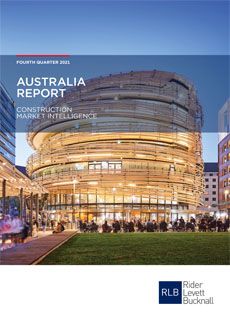According to leading global quantity surveyor and cost consultant Rider Levett Bucknall’s (RLB) 4th Quarter 2021 Australia Report, upward pressure on contractor tender pricing is being seen across the country, albeit at differing levels.
Mr Domenic Schiafone, Research and Development Director of RLB said, “Melbourne, Canberra, Adelaide and Darwin have observed stable expected increases. In contrast, significant surges in tender pricing have been experienced in Brisbane, Perth and Sydney; escalations for FY 2021 are well above levels forecast at the backend of FY 2020.”
“This is surprising as both Queensland and Western Australia have experienced limited lockdowns, and therefore less impact on construction activity. The key difference in both states has been the introduction of significant border closures,” he added.
According to RLB, the upward pressure on construction pricing is being influenced by several factors, including restrictions on the movement of labour and materials, both nationally and internationally; raw material price increases; higher Enterprise Bargaining Agreement (EBA) rates; and additional on-site plant and labour requirements due to COVID-19.
Strong demand for labour and materials
Demand for both labour and materials remains high, particularly in trades that crossover with the civil and infrastructure sector. The upward trend in labour costs is being driven from the bottom by strong volumes of single dwelling housing, and from the top by increasing demand within the mining and resource sector.
During calendar year 2021, the price of materials has increased, particularly for concrete, steel, reinforcement, timber, and PVC based products used in hydraulic and electrical trades. This has been compounded by record high prices for raw materials, such as copper and iron ore. These price rises have prompted some trades to specify supply rates as a condition of tender pricing, resulting in a price adjustment should supply rates increase. Similarly, hold prices from steel suppliers have diminished, with increases upwards of 20% observed since October 2020 from some suppliers.
Price increases to continue
Mr Schiafone continued, “Further material price increases have been flagged over the next 3 to 6 months. Recent tender results for other trades convey a slightly different scenario. Finishes and some services trades have remained stable.”
“This is perhaps reflective of the decline in multi-level apartment developments and the mixed outlook for the sector. Not surprisingly, contractors’ preliminaries have increased as a result of COVID-19 conditions. Contractor margins remain within expected ranges, indicating that the appetite to secure pipelines of work remain strong,” he said.
Further impacts to come
Supply chain instability and global freight and shipping issues are well documented. Contractors have emphasised the potential for material shortages, shipping cost increases and delays in the arrival of imported goods and equipment. At this stage, these supply chain issues have not had a significant impact on recent tender pricing. However, there appears to be growing pressure and perhaps further impacts to come.
RLB believes that specific inputs into construction costs are generating several opposing factors. Key escalation insights from RLB offices around Australia include:
Keeping pricing stable
- In general, the industry is likely to have a latent capacity for projects towards the end of 2021 and into 2022, due to falling levels of activity (compared to the two-to-three years prior to the pandemic)
- While supply chain issues and disruptions of imported materials are evident, there is some optimism that improvements will be seen in 2022; international production levels are expected to increase as regions recover from COVID-19 and return to normal.
- Contractors have sourced alternative supply chain arrangements for certain elements of trades with direct procurement from non-traditional global markets (such as the Americas in lieu of China)
- Some contractors and key subcontractors report falling opportunities for tendering in the next six months. Margins are being tightened to fill and maintain workbooks
- In some states, there are fewer projects of significant size and scale in the pipeline. This suggests that a competitive tender market can be anticipated for larger scale projects
Driving pricing upwards
- Government related and funded projects have enabled activity to remain at high levels in the infrastructure related sectors, as well as in the emerging sectors of affordable housing and build-to-rent
- The movement of labour and materials due to civil and infrastructure projects is arguably at its peak and will continue at this level for some time
- Due to current border closures, it is unlikely that there will be significant inflow of labour from both overseas and interstate for some time to offset the demand for labour in most states. Material price increases are well documented with contractors and suppliers forecasting his trend to continue
- Changing work practices due to COVID-19 restrictions continue to evolve, placing pressure on contractor programmes and reducing on-site productivity. This flows through to increased preliminaries costs
- Supply chain issues are evident with long lead times for materials and price increases. For example, the US market, appears to be a more lucrative option for logistics operators and manufacturers – the US market is prepared to negotiate higher shipping prices to the detriment of smaller markets, such as Australia
Rise in steel and concrete material prices
Steel suppliers have increased material prices upwards of 20% since October 2020, with shortened price hold dates on steel reinforcement. Further increases may be forthcoming. Concrete supply has risen 3% to 4% in the same timeframe and another rise is expected shortly.
Mr Schiafone concluded, “The lead times for some products are growing. Timber products (such as certain types of flooring‚ have blown out to beyond 6 months, compared to the standard 8 to 10 weeks. As a result, suppliers are unable to guarantee pricing.”
Pricing volatility within Sydney market
This has been most evident in Sydney where the analysis of current tender prices received in early December has resulted in revisions to the published 2021 and 2022 TPI uplifts. The published uplifts, within this report, of 1.2% and 2.0%, have been recently revised to 4.1% and 5.6% respectively. This sudden change in RLB’s escalation forecasts, highlights the current pricing volatility within the Sydney market, which is only truly reflected when project tender prices are received and reviewed.
RLB’s current construction escalation forecasts for 2021 indicate that all key Australian cities have increased their TPI estimates from that forecast six months ago, with the exception of Darwin which did not change.
While construction costs in Brisbane, Perth and Sydney significantly increased, the remaining capital cities have not experienced this level of volatility. In 2022, general escalation should be relatively stable, with cost increases lower than 3.5% expected in most cities.
FURTHER INFORMATION:



